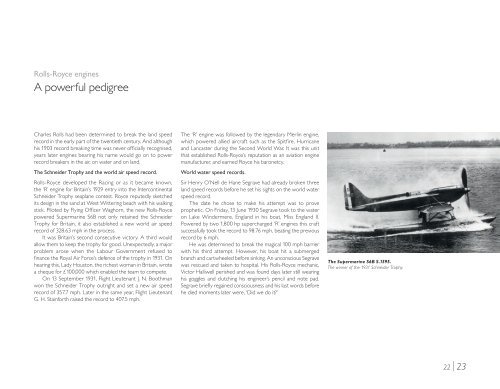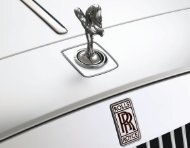Rolls-Royce Phantom Brochure - Rolls-Royce Motor Cars Raleigh
Rolls-Royce Phantom Brochure - Rolls-Royce Motor Cars Raleigh
Rolls-Royce Phantom Brochure - Rolls-Royce Motor Cars Raleigh
You also want an ePaper? Increase the reach of your titles
YUMPU automatically turns print PDFs into web optimized ePapers that Google loves.
<strong>Rolls</strong>-<strong>Royce</strong> enginesA powerful pedigreeCharles <strong>Rolls</strong> had been determined to break the land speedrecord in the early part of the twentieth century. And althoughhis 1903 record breaking time was never officially recognised,years later engines bearing his name would go on to powerrecord breakers in the air, on water and on land.The Schneider Trophy and the world air speed record.<strong>Rolls</strong>-<strong>Royce</strong> developed the Racing or as it became known,the ‘R’ engine for Britain’s 1929 entry into the IntercontinentalSchneider Trophy seaplane contest. <strong>Royce</strong> reputedly sketchedits design in the sand at West Wittering beach with his walkingstick. Piloted by Flying Officer Waghorn, the new <strong>Rolls</strong>-<strong>Royce</strong>powered Supermarine S6B not only retained the SchneiderTrophy for Britain, it also established a new world air speedrecord of 328.63 mph in the process.It was Britain’s second consecutive victory. A third wouldallow them to keep the trophy for good. Unexpectedly, a majorproblem arose when the Labour Government refused tofinance the Royal Air Force’s defence of the trophy in 1931. Onhearing this, Lady Houston, the richest woman in Britain, wrotea cheque for £100,000 which enabled the team to compete.On 13 September 1931, Flight Lieutenant J. N. Boothmanwon the Schneider Trophy outright and set a new air speedrecord of 357.7 mph. Later in the same year, Flight LieutenantG. H. Stainforth raised the record to 407.5 mph.The ‘R’ engine was followed by the legendary Merlin engine,which powered allied aircraft such as the Spitfire, Hurricaneand Lancaster during the Second World War. It was this unitthat established <strong>Rolls</strong>-<strong>Royce</strong>’s reputation as an aviation enginemanufacturer, and earned <strong>Royce</strong> his baronetcy.World water speed records.Sir Henry O’Nell de Hane Segrave had already broken threeland speed records before he set his sights on the world waterspeed record.The date he chose to make his attempt was to proveprophetic. On Friday, 13 June 1930 Segrave took to the wateron Lake Windermere, England in his boat, Miss England II.Powered by two 1,800 hp supercharged ‘R’ engines this craftsuccessfully took the record to 98.76 mph, beating the previousrecord by 6 mph.He was determined to break the magical 100 mph barrierwith his third attempt. However, his boat hit a submergedbranch and cartwheeled before sinking. An unconscious Segravewas rescued and taken to hospital. His <strong>Rolls</strong>-<strong>Royce</strong> mechanic,Victor Halliwell perished and was found days later still wearinghis goggles and clutching his engineer’s pencil and note pad.Segrave briefly regained consciousness and his last words beforehe died moments later were, ‘Did we do it?’The Supermarine S6B S.1595.The winner of the 1931 Schneider Trophy.22 23



